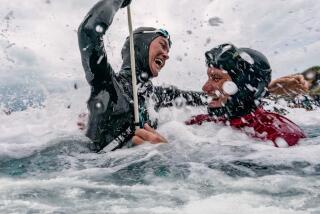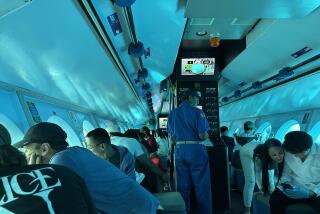MIKE deGRUY: To Sea What They Can See
- Share via
The underwater realm is often called the silent world because submerged divers ordinarily cannot speak to each other. In “National Geographic Explorer: Sea Trek,” a new technological development called a bubble helmet allows co-hosts Mike deGruy and Martha Holmes to transform the silent world into the talkative world.
In Sunday’s premiere episode, “Sea Trek: The Galapagos Islands,” deGruy and Holmes joke with each other as playful sea lions surround them. “Look at what is happening to Peter’s camera,” deGruy laughs as a sea lion chomps on a cable. “The sea lions want to look nice underwater so they pay very careful attention to the lighting.”
Later as the frame moves in on deGruy and Holmes hanging suspended in the water, deGruy looks directly at the camera and says as though the viewer were floating beside him, “If you wonder what we’re doing, it’s as it appears. We’re waiting. For hammerheads.” Out of the shadows the bizarre shapes of the hammerhead sharks slowly emerge like misshapen gray ghosts.
Throughout the program, the three-way conversations among deGruy, Holmes and the camera plus some truly remarkable underwater footage give the viewers the feeling they are swimming beside Holmes and deGruy. Future episodes of the five-part series will take the audience to California kelp forests, the Caribbean, the Great Barrier Reef and the Hawaiian Islands.
Co-host Mike deGruy, a marine scientist and noted underwater cameraman, talked with writer Noel Davis about the series.
You are well known as an underwater cameraman. What was it like to step in front of the camera and be the host and guide?
It was strange. I’m still not quite adjusted to it. It surprised me a little how difficult it was. The whole premise of “Sea Trek” was to have fun and to take a lighthearted approach to showing some things about the ocean. I thought that it would be fairly easy just to act naturally, but it doesn’t turn out that way. I’m much more comfortable behind the camera than in front of it. It’s awkward for me to see myself.
What did the bubble helmet allow you to do that you hadn’t been able to do with conventional diving equipment?
First of all, it allowed something that I personally had never experienced. It allowed us to freely and comfortably speak to each other underwater. Normally during a dive you are communicating by awkward hand signals. It is not until you come back to the boat that you can talk about what happened. With the bubble helmet, you talk about it just as you and I are talking now.
The other thing that it did was that it allowed us to describe things with this acrylic sphere around our heads. Our heads would be perfectly dry and the audience could see our faces so clearly. They could see our mouths, our eyes and our facial expressions. This isn’t the first time underwater conversation has been on television, but it’s the first time that you could actually see two people talking to each other without big masks in front of their faces.
What does “Sea Trek” have to offer that has not been done before in underwater television programs?
There is a certain immediacy and accessibility. The key to “Sea Trek” was to bring the audience right down there with us. Martha and I could talk to each other and then just as easily turn and speak to the camera. I think it is unique the way we put the audience right there so that they are seeing and meeting the animals along with us.
What kinds of underwater encounters does “Sea Trek” show that have never been seen before?
In the Galapagos show, we have a sequence which shows penguins feeding on a school of fish. That footage was actually a stroke of luck.
We’d been trying to get penguin footage for weeks, but we had been frustrated because they’d just zoom by the frame and be gone. One day I got up early in the morning and I noted a huge school of fish that penguins were feeding on. I grabbed a camera and went over to the school of fish. I decided to forget about the penguins and just shoot the fish. I sat for two or three hours with this big ball of small fish and, lo and behold, the penguins came and started feeding right in front of me. I knew that penguins fed on small fish but I had never witnessed it.
What were the most difficult scenes to shoot?
We have a sequence of iguanas feeding underwater that was probably physically the most difficult we did in the Galapagos because it took place in an incredible surge area. You can imagine the size of those video cameras. They are just enormous and then there’s a cable connected to a recorder. As a package it is not something you would normally take into a huge swell and surge and surf area with rocky bottom, but, fools that we were, we did and ended up getting the material.
What was your biggest thrill?
One of the biggest thrills, believe it or not, was those penguins because I was shooting that and it was happening right in front of me. Right next to the penguins, pelicans were coming in with their huge mouths and scooping out the fish. They choose not to use the pelican footage, but it was an amazing scene happening all around me and I was alone. There were those penguins diving all over the place and pelicans crashing around my head. It was wild.
“National Geographic Explorer: Sea Trek” airs Sunday at 6 p.m. on TBS.
More to Read
The complete guide to home viewing
Get Screen Gab for everything about the TV shows and streaming movies everyone’s talking about.
You may occasionally receive promotional content from the Los Angeles Times.






